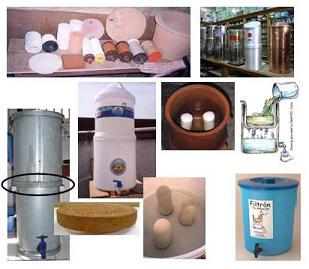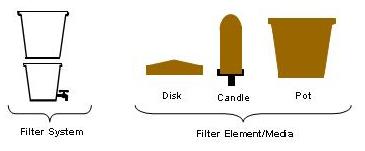Ceramic water filters have been used in various places around the world as a means of treating drinking water at the household level. The fact that ceramic filters can be manufactured and produced by local ceramists with local materials makes them particularly attractive as a household water treatment technology that is affordable, appropriate, and sustainable. Some examples include the Potters for Peace Filtron (Nicaragua), the TERAFIL terracotta filter (India), and the candle filter (India, Nepal, Bangladesh, Brazil, etc).
What
research has been done suggests that the commercially available
ceramic water filter systems in places such as India, Nepal, Nicaragua,
and Brazil are a step in the right direction, but could be improved
to better meet the safe drinking water needs of citizens. In particular,
many commercially available filter systems are too expensive for
the poor who are suffering the most from waterborne diseases. Several organizations, including MIT, are currently pursuing laboratory and field research on the effectiveness of ceramic water filters. This year, the MIT Nepal Water Project continued research on the feasibility of developing a new disk-filter prototype that could potentially eliminate some of the problems associated with existing filters, at a retail price that is affordable to the poor. |
|||||||||||||
Ceramic water filters can be categorized according to various key parameters:
Ceramic water filters can also be described by their function(s):
Other key variables that influence the properties of ceramic water filters include:
The entire filter unit is often defined in terms of two components: the filter element or media through which water passes and the filter system which houses the media, usually consisting of an upper and lower storage vessel for holding water (see diagram at below). |
|||||||||||||
Ceramic water filters can help improve water quality in terms of:
Typical flow rates: 1-4 L/hr For information on water quality guidelines: World Health Organization Guidelines for Drinking Water Quality. |
|||||||||||||
|
|||||||||||||
| Pros | Cons | ||||||||||||
|
|
||||||||||||
|
Prices vary depending on the country, but typically range from $5.00 US to $30.00 US for a complete filter system. Household ceramic water filters in industrialized countries typically cost a lot more; on the order of $100's of dollars.
|
|||||||||||||
Links to Websites and Information Resources
|
|||||||||||||
 Although
the use of ceramic water collection and storage vessels goes back
centuries, there is little documentation and testing of the effectiveness
of low-cost ceramic water filters both in the laboratory and especially
in the field in developing countries.
Although
the use of ceramic water collection and storage vessels goes back
centuries, there is little documentation and testing of the effectiveness
of low-cost ceramic water filters both in the laboratory and especially
in the field in developing countries.